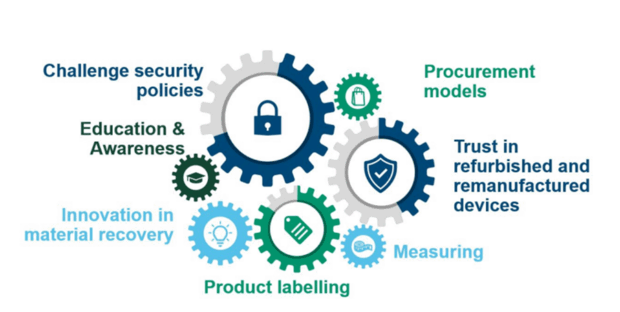Emily Watson-Breeze is a Sustainability Activation Manager at BT and is a member of the Government Digital Sustainability Alliance (GDSA) circular economy working group. The views in this post are their own and not the UK government’s.

Driving Circularity in Government: New Recommendations from the GDSA circular economy working group
Circular economy principles are gaining traction across all industries—but within government departments and large organisations, adoption remains limited. That’s why the GDSA circular economy working group is proud to release our recommendations paper, a practical guide to overcoming the barriers that hinder circularity in public sector ICT.
This paper not only identifies the key challenges but also offers actionable solutions to help organisations transition from linear to circular models of technology use.
About the paper
The recommendations paper is the result of a collaborative effort by the circular economy working group, co-authored by:
- Emily Watson-Breeze (Sustainability Activation Manager, BT)
- Mimi Moll (former IT and Telecoms Sustainability Lead, n2s)
Their insights, first presented at the GDSA summit in March 2024at the London Science Museum, laid the foundation for this work. Their leadership and insights have been instrumental in shaping this paper, which builds on those discussions. Since then, the group has expanded, welcoming new voices from industry and academia.
We’re also excited to share that Ishmael Burdeau (Lead Sustainability Business Architect, DWP) and Ellie Richardson (Head of Donations, DSIT) have joined the conversation, bringing fresh perspectives on end-of-life hardware and e-waste.
Why circularity in tech matters
In our digital age, the responsible management of technology is more important than ever. Circularity in tech means designing products with their full lifecycle in mind—so they can be reused, refurbished or recycled instead of ending up in landfills.
This approach:
- conserves valuable resources
- reduces environmental impact
- cuts down on one of the world’s fastest-growing waste streams: e-waste
Whether you’re an individual or an organisation, it’s time to rethink what happens to your old devices. Let’s stop letting them gather dust and start putting them back into use, through our collective resource bank.
Barriers to circularity
Our research, based on primary research from interviews with government employees and industry peers, highlights 6 critical barriers and opportunities:
- Legacy technology, e-waste and value recovery: Managing end-of-life technology and recovering value from e-waste is a pressing issue, with many organisations struggling to implement effective recovery programs and hoarding devices and cables.
- The linear nature of procurement and budgets: Traditional procurement practices prioritise short-term savings over long-term sustainability, making it difficult to invest in circular solutions and reclaim residual value from devices.
- Trusting refurbished and remanufactured devices: Scepticism about the reliability of refurbished products discourages adoption, even as steps are being made to offer low-carbon alternatives.
- Need for circular product design: Many products are not designed for circularity, limiting repairability and reuse, often due to planned obsolescence.
- Role of education – knowledge and context to drive change: A lack of understanding about circular principles hampers progress, emphasizing the need for education about the environmental impact of technology.
- Measuring circularity through Scope 3 emissions: Inconsistent standards for measuring Scope 3 emissions hinder informed decision-making, requiring greater transparency and standardisation.
We refer to these as parts of a “sustainability engine”—and overcoming each one brings us closer to a truly circular economy.

What’s next?
This paper is just the beginning. Our working group will now:
- dive deeper into each barrier
- host webinars and workshops
- develop practical “how-to” guides for government departments for; mobility, workplace and enterprise devices
- collaborate with stakeholders across sectors
Join the movement
We invite central government departments, public bodies and industry partners to explore the paper and get involved.
If your organisation is facing challenges with tech disposal, procurement or sustainability, we want to hear from you. Let’s work together to build a more circular, responsible future for public sector ICT.
For more information, read the GDSA recommendations paper.

Leave a comment